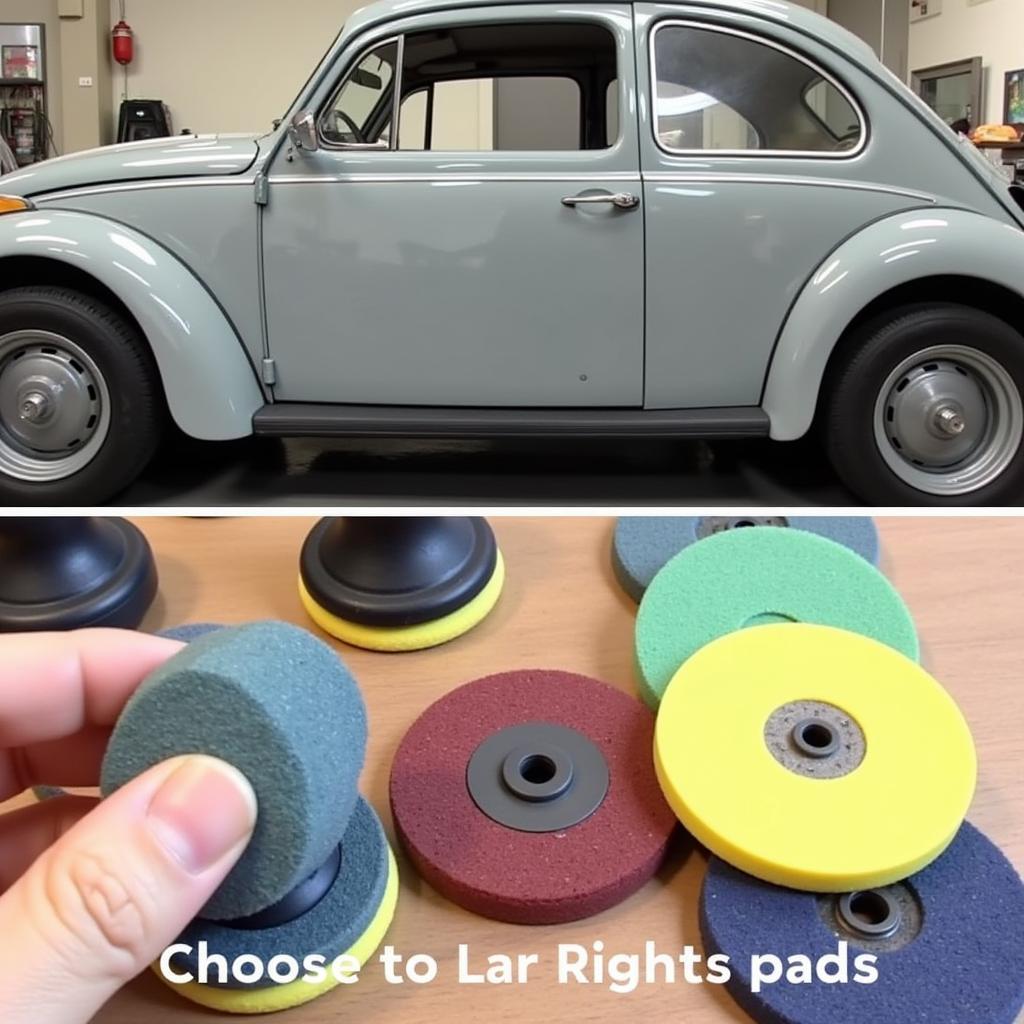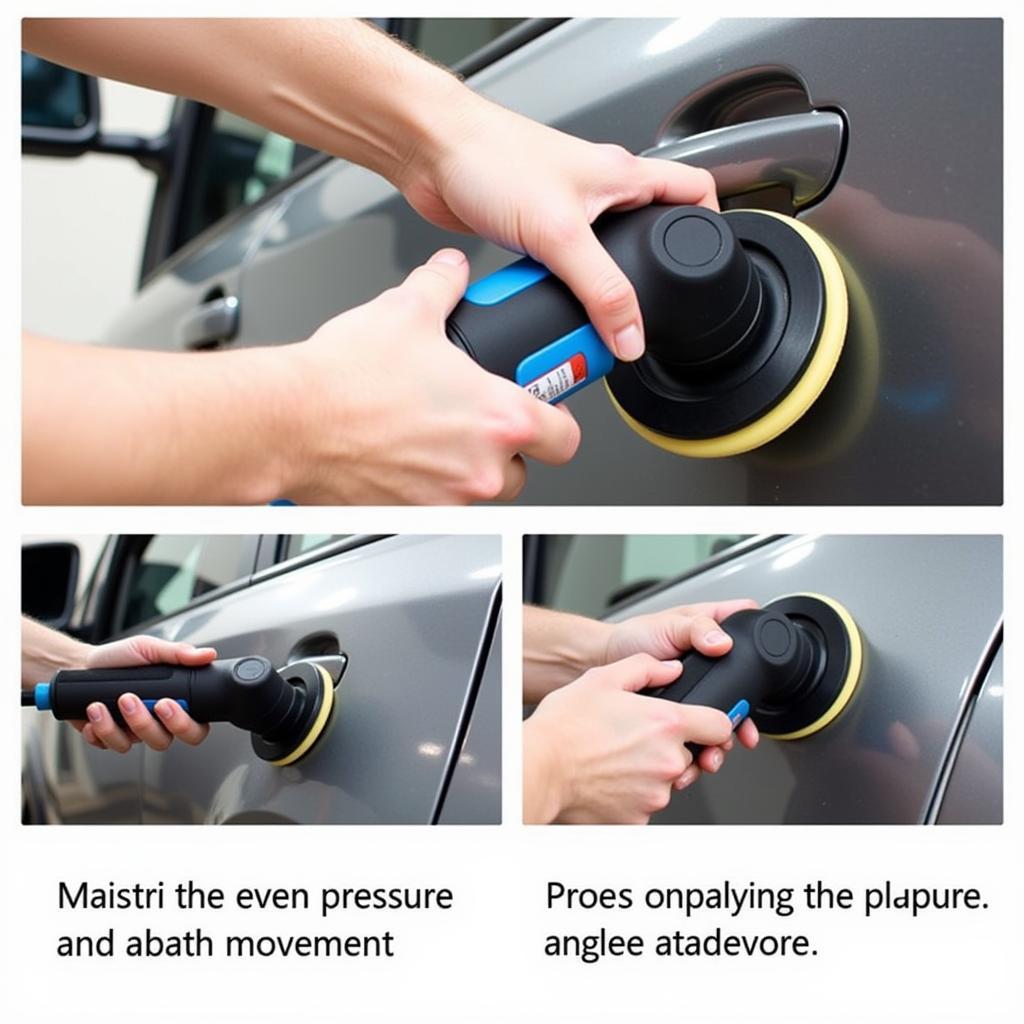Using a rotary tool to buff a car can seem daunting, but with the right knowledge and technique, it can transform your vehicle’s appearance. This guide will provide you with a step-by-step approach, expert tips, and answers to frequently asked questions to help you achieve a professional-looking finish.
Understanding the Power of the Rotary Tool
Rotary tools are powerful and versatile tools that can be used for a variety of car detailing tasks, including buffing. They offer greater speed and control compared to other buffing methods, allowing you to remove scratches, swirls, and other imperfections more effectively. However, this power comes with responsibility. Used incorrectly, a rotary tool can easily damage your car’s paint. Therefore, understanding the tool’s capabilities and limitations is crucial. Are you looking for ways to enhance your car’s finish? Check out these car paint finishing tools.
Preparing Your Car for Buffing
Before you begin using a rotary tool to buff your car, thorough preparation is essential. Start by washing your car thoroughly to remove any dirt, grime, or debris. Then, carefully inspect the paint for any deep scratches or chips. These might require separate treatment before buffing. Finally, mask off any areas you don’t want to buff, such as trim, rubber seals, and plastic parts. This will protect them from accidental damage. Choosing the correct buffing pad is also crucial for achieving the desired results. For more information on buffing tools, see our guide on buffing tools for cars.
 Preparing a Car for Buffing with a Rotary Tool
Preparing a Car for Buffing with a Rotary Tool
Step-by-Step Guide to Buffing with a Rotary Tool
- Choose the Right Buffing Pad and Compound: Selecting the appropriate pad and compound is crucial. Start with a less aggressive combination and gradually move to more aggressive options if needed.
- Apply the Compound: Apply a small amount of compound to the buffing pad. Spread it evenly over a small section of the car’s paint (about 2ft x 2ft).
- Start the Rotary Tool: Begin with a low speed setting and hold the tool firmly. Maintain a flat, even pressure on the pad.
- Move the Tool Slowly and Evenly: Avoid staying in one spot for too long, as this can cause heat buildup and damage the paint. Overlap each pass slightly to ensure even coverage.
- Inspect Your Work Regularly: Stop frequently to check your progress and ensure you’re not removing too much paint.
- Repeat the Process: Continue buffing small sections of the car until you’ve covered the entire surface.
- Wipe off Excess Compound: Use a clean microfiber cloth to remove any remaining compound.
 Correct Technique for Using a Rotary Tool to Buff a Car
Correct Technique for Using a Rotary Tool to Buff a Car
Common Mistakes to Avoid
- Using Too Much Pressure: Excessive pressure can create uneven spots and even burn through the clear coat.
- Moving the Tool Too Quickly: This can lead to swirl marks and an uneven finish.
- Using the Wrong Buffing Pad or Compound: An incorrect combination can be ineffective or even damage the paint.
- Staying in One Spot for Too Long: This can generate excessive heat and damage the paint.
For a gentler approach to buffing, consider using a car palm buffing tool.
Tips for Achieving a Professional Finish
- Practice on a Less Visible Area: Before tackling the entire car, practice on a less noticeable area to get a feel for the tool and technique.
- Keep the Buffing Pad Clean: Regularly clean the pad to prevent build-up and ensure optimal performance.
- Work in a Well-Ventilated Area: Buffing compounds can produce dust and fumes.
- Use High-Quality Products: Investing in quality compounds and pads can significantly improve your results. Explore more car detailing tools, including buffers, at car detailing tools buffer.
Conclusion
Using a rotary tool to buff a car can be a rewarding experience, yielding a professional-looking shine. By following the steps outlined in this guide, avoiding common mistakes, and employing the expert tips provided, you can achieve stunning results. Remember to prioritize safety and practice patience for the best possible outcome.
FAQs
- Can I use a rotary tool on all types of car paint? Yes, but be extra cautious with older or thinner paint.
- How often should I buff my car? It depends on the condition of your car’s paint, but generally, once or twice a year is sufficient.
- What’s the difference between a rotary tool and a dual-action polisher? Rotary tools are more powerful but require more skill, while dual-action polishers are safer for beginners.
- How do I choose the right buffing compound? Consider the severity of the imperfections you want to remove and the type of paint your car has.
- Can I use a rotary tool to remove deep scratches? While a rotary tool can remove some scratches, deep scratches may require professional attention.
- What are the best safety precautions when using a rotary tool? Wear safety glasses and gloves, and work in a well-ventilated area.
- How do I clean my rotary tool after use? Follow the manufacturer’s instructions for cleaning and maintenance.
Car Wash Power Tool Guide
For tips on choosing the best power tools for washing your car, check out our guide on ideal power tools car wash.
Need More Help?
For further assistance with car diagnostics and detailing, browse our other helpful articles or contact us directly.
Contact Us:
WhatsApp: +1(641)206-8880
Email: [email protected]
Address: 910 Cedar Lane, Chicago, IL 60605, USA.
We offer 24/7 customer support.

Leave a Reply